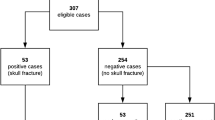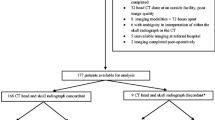Abstract
Background
The value of 3-D skull models in evaluation of young children with suspected child abuse is not known.
Objective
The purpose of this study was to assess the value of 3-D skull models as a problem-solving tool in children younger than 2 years.
Materials and methods
We performed a retrospective study on 73 children (ages 0–24 months) seen by a child protection team (CPT) who were undergoing head CT between August 2007 and July 2009.
Results
Of the 73 children, volume-rendered 3-D models were obtained in 26 (35.6%). Three-dimensional models changed initial CT interpretation in nine instances (34.6%). Findings thought to be fractures were confirmed as normal variants in four children. Depressed fractures were correctly shown to be ping-pong fractures in two cases. In one case, an uncertain finding was confirmed as a fracture, and an additional contralateral fracture was identified in one child. A fracture seen on skull radiographs but not seen on axial CT images was identified on the 3-D model in one case. Changes in interpretation led to modification in management in five children.
Conclusion
Use of 3-D skull models can be a problem-solving tool when there is discordance among the CT reading, subsequent radiographic investigations and clinical evaluation.





Similar content being viewed by others
References
Tung GA, Kumar M, Richardson RC et al (2006) Comparison of accidental and nonaccidental traumatic head injury in children on noncontrast computed tomography. Pediatrics 118:626–633
Foerster BR, Petrou M, Lin D et al (2009) Neuroimaging evaluation of non-accidental head trauma with correlation to clinical outcomes: a review of 57 cases. J Pediatr 154:573–577
Kemp AM, Butler A, Morris S et al (2006) Which radiological investigations should be performed to identify fractures in suspected child abuse? Clin Radiol 61:723–736
Medina LS (2000) Three-dimensional CT maximum intensity projections of the calvaria: a new approach for diagnosis of craniosynostosis and fractures. Am J Neuroradiol 21:1951–1954
Mulroy MH, Loyd AM, Frush DP et al (2012) Evaluation of pediatric skull fracture imaging techniques. Forensic Sci Int 214:167–172
Choudhary AK, Jha B, Boal DK et al (2010) Occipital sutures and its variations: the value of 3D-CT and how to differentiate it from fractures using 3D-CT? Surg Radiol Anat 32:807–816
Section of Radiology, American Academy of Pediatrics (2009) Diagnostic imaging of child abuse. Pediatrics 123:1430–1435
Perez-Rossello JM, Connolly SA, Newton AW et al (2010) Whole-body MRI in suspected infant abuse. Am J Roentgenol 195:744–750
Wei SC, Ulmer S, Lev MH et al (2010) Value of coronal reformations in the CT evaluation of acute head trauma. Am J Neuroradiol 31:334–339
Zacharia TT, Nguyen DT (2010) Subtle pathology detection with multidetector row coronal and sagittal CT reformations in acute head trauma. Emerg Radiol 17:97–102
Arnholz D, Hymel KP, Hay TC et al (1998) Bilateral pediatric skull fractures: accident or abuse? J Trauma 45:172–174
Kleinman PK, Barnes PD (1998) Diagnostic imaging of child abuse, 2nd edn. Mosby, St. Louis
Zia Z, Morris AM, Paw R (2007) Ping-pong fracture. Emerg Med J 24:731
Prabhu SP, Young-Poussaint T (2010) Pediatric central nervous system emergencies. Neuroimaging Clin N Am 20:663–683
White KS (1996) Invited article: helical/spiral CT scanning: a pediatric radiology perspective. Pediatr Radiol 26:5–14
Hu H (1999) Multi-slice helical CT: scan and reconstruction. Med Phys 26:5–18
Tzedakis A, Perisinakis K, Raissaki M et al (2006) The effect of z overscanning on radiation burden of pediatric patients undergoing head CT with multidetector scanners: a Monte Carlo study. Med Phys 33:2472–2478
Halpin SF (2004) Brain imaging using multislice CT: a personal perspective. Br J Radiol 77:S20–S26
Abdeen N, Chakraborty S, Nguyen T et al (2010) Comparison of image quality and lens dose in helical and sequentially acquired head CT. Clin Radiol 65:868–873
Schilham A, van der Molen AJ, Prokop M et al (2010) Overranging at multisection CT: an underestimated source of excess radiation exposure. Radiographics 30:1057–1067
Bushberg JT (2012) The essential physics of medical imaging, 3rd edn. Wolters Kluwer Health/Lippincott Williams & Wilkins, Philadelphia
Strauss KJ, Goske MJ, Kaste SC et al (2010) Image gently: ten steps you can take to optimize image quality and lower CT dose for pediatric patients. Am J Roentgenol 194:868–873
Philipp MO, Kubin K, Mang T et al (2003) Three-dimensional volume rendering of multidetector-row CT data: applicable for emergency radiology. Eur J Radiol 48:33–38
Fishman EK, Ney DR (1993) Advanced computer applications in radiology: clinical applications. Radiographics 13:463–475
Kuszyk BS, Heath DG, Bliss DF et al (1996) Skeletal 3-D CT: advantages of volume rendering over surface rendering. Skeletal Radiol 25:207–214
Conflicts of interest
None.
Author information
Authors and Affiliations
Corresponding author
Rights and permissions
About this article
Cite this article
Prabhu, S.P., Newton, A.W., Perez-Rossello, J.M. et al. Three-dimensional skull models as a problem-solving tool in suspected child abuse. Pediatr Radiol 43, 575–581 (2013). https://doi.org/10.1007/s00247-012-2546-4
Received:
Revised:
Accepted:
Published:
Issue Date:
DOI: https://doi.org/10.1007/s00247-012-2546-4




